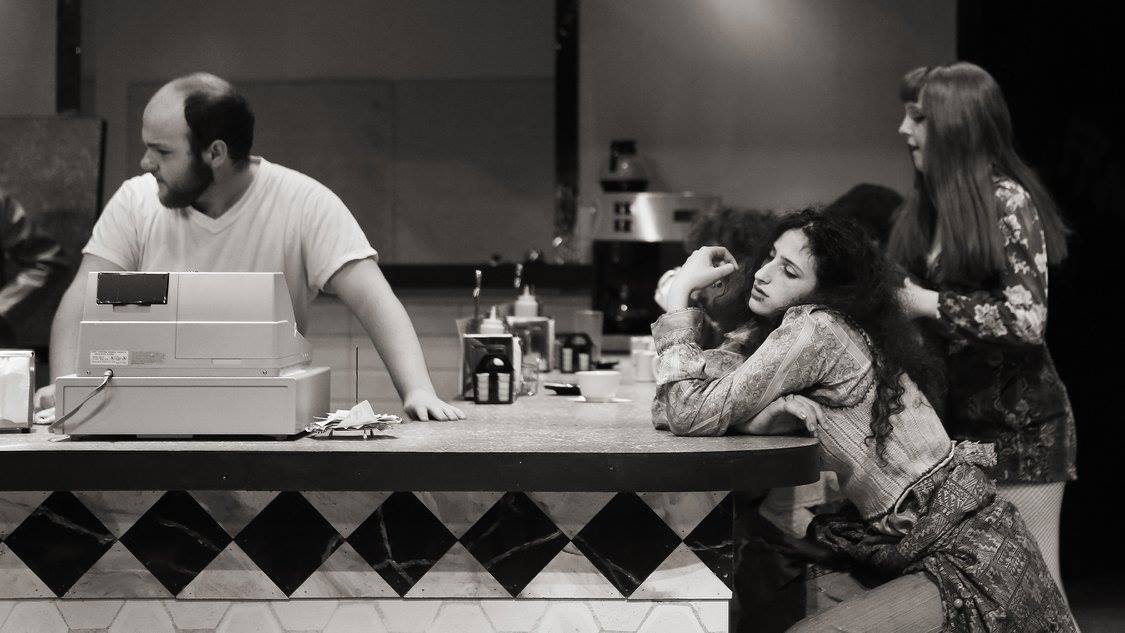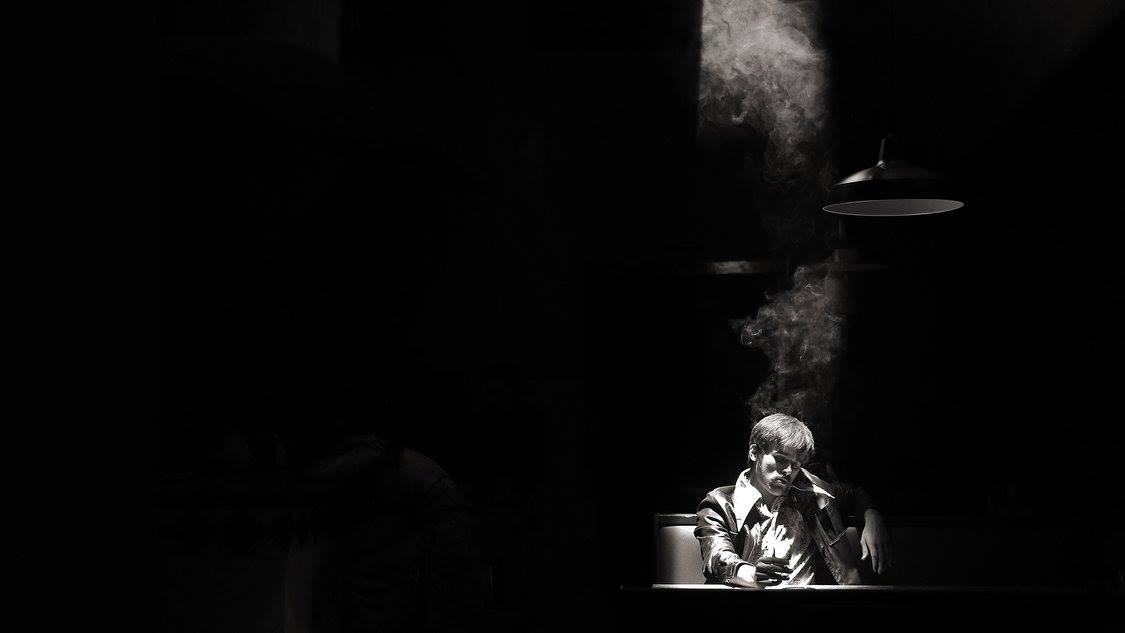By Rachel Karp ’18
Three Rules of “Balm in Gilead”:
1.) There is an 85 cent minimum to sit at a booth.
2.) A junkie never falls off his stool.
3.) Dopey is our guide in this world of chaos, and the audience’s only hope of knowing where to look.

Photo by Sue Kessler
A dark, dingy diner. Dopey, played by Wiley Hopkins ’19, enters. He eyes the audience and gestures for House Manager, Michael San Roman ’17, to make his pre-show announcement. Dopey pulls out a cigarette, sniffs it, lights it, raises it the air, and brings it down to point at the juke-box sitting dormant in the corner of the diner. It lights up red and green and Bruce Springsteen’s Thunder Road floods the space as lights rise on the set.
Immediately, we are thrown into an exact replica of a grungy, 1970’s diner in Manhattan. The set, designed by Gary Wilson and assistant designed by Nola Donkin ’18 and Sarah Markley ’19, does not miss a single detail. Next to the jukebox sits a cigarette machine, on the other side of the diner a rotary payphone. The blue, vinyl, diner booths and red vinyl-topped stools look as if they came straight out of an old diner itself. Each individual floor tile and cracked square of side-walk are precisely painted.
The space comes to life. Judy (Annabelle Vaës ’19), stands and yells; Babe (Lena Schwartz ’19) sleeps at the counter; Tig (Sadiq Ahmed ’20) enters pointing and shouting; Kay (Anabel Milton ’18), a waitress, wipes tables. I catch only snippets of dialogue. “Eight bambinos!” declares Rust (Devin McDonough ’17). “What the hell is this? 85 cents for one Coke?” yells Bonnie (Kirsten Mulrenan ’18). “I happen to like tits, you got tits?” questions Bob (Shea Leavis ’17). It is impossible to take in everything at once.

Photo by Sue Kessler
Fortunately, we have Dopey to guide our focus. He seems to control the space itself, and with a snap of his fingers, the stage goes dark, save for a singular light on Joe (Chris Naughton ’17). Under Dopey’s careful guidance, the narrative begins to unfold. Balm in Gilead tells the classic boy-meets-new-girl-in-town story. Darlene (Sydney Tennant ’18) has just moved to Manhattan from Chicago. She meets Joe, a local drug-dealer, and inadvertently drives him to question his illicit lifestyle.
Balm in Gilead, however, does not rely on this central storyline. As Naughton explains, “something we discussed throughout the process is how the conventionality of Joe and Darlene’s storyline allows for the rest of the play to go insane.” The true power of the production lies in the world of the play, carefully constructed through a collage of vivid moments, images, sounds and characters. At times, this world is so visceral that I forget I am sitting in a theater. While Dopey does lead us through the main action of the play, he also points our attention to other moments. A snap from Dopey illuminates Fick (Josh Wagner ’17), rapidly mumbling to himself at the bar, so quietly I could have missed it entirely amongst the chaos. Another snap reveals Schwartz’s drug-addict Babe, passed out at the counter, stirring slightly to sputter and cough. Simple images such as a cigarette smoke spiral caught in a beam of light transport us to another time and place. Music, too, serves to construct the world. Bruce Springsteen and Tom Waits blast from the speakers, sometimes even drowning out the actors themselves.

Photo by Sue Kessler
The play’s second act is quieter than the first. Darlene spends much of the act telling Ann, a local prostitute (Lulu Fairclough-Stewart 19) about her past love, a man named Cotton. Again, the second act’s strength lies not in the story itself. Rather, it is derived from the specificity of the choices made by director Phil Soltanoff and the ensemble. Tennant remains strikingly static as she speaks. Watching Ann watch Darlene is as compelling as listening to Darlene herself, thanks to Stewart’s nuanced performance. As the play comes to a close, Dopey directs everyone’s exits. Darlene remains alone, and utters her last line, “Christ, aren’t we even moving?” With this, the singular stream of light on her fades, so slowly I do not notice it is getting darker until there is barely any light left at all.
CAST REFLECTIONS
Chris Naughton ’17 (Joe): There was this cool overlap between Phil’s directing style and the actual driving idea of the play. Because for so many people in this diner, this is a safe place for them, but they are trapped here because they know it. And Phil’s approach was to have us constantly repeating things, which would eventually lead us to knowing it so well and distilling each scene to exactly what it meant to us that we could find freedom.
Billy Winter ’18 (David): The rehearsal process was so conducive to getting in touch with our characters and the world of the show. I was a little skeptical at first because we didn’t touch the text or even find out our roles for the first couple weeks. Phil had us doing a lot of group-mind types of activities and that really helped to build this ensemble and create this sense of community. Once we did get into working with the script, we already had a natural sort of back-and-forth with each other which this show very much clings to. Phil is an absolutely brilliant artist. And he’ll deny it, but I think he knew exactly what he was doing throughout this entire process. Everything he had us do was purposeful and helped us along the way. It was a truly skillful orchestration. This show needs organized chaos to really take off and captivate an audience. If it doesn’t have that, it’ll fall flat. We needed to find the melody of the piece, Phil would say. And he didn’t show us the answers, but pushed us and guided us in the right way to find them ourselves. I think that’s what a great director does.
Liel Dolev ’20 (Franny): Balm in Gilead was a valuable experience in many ways. Inherently, the play is such a challenge for actors because each character seems cliched, and often does have cliched tendencies. The pitfall that I tried to avoid was playing the easy way out, that is, playing the cliche of my character. Because I played a drag queen, it would have been easy to just perform the lines to the audience to try to “steal the show” or “get the laughs.” However, I found it much more valuable for me to explore the truth of my character and then find the mask that covers that truth. Phil constantly pushed me to find what Franny’s cover is, what his weak spots are, and why he acts the way he does. In addition, it was such a gift that Phil has a talented eye of spotting what is truthful to the situation and what is not.
Samantha Fleishman ’20 (Terry): One day during rehearsal I dropped one of my lines because I/Terry was fuming so passionately in a scene that I lost sight of the script, or rather I got lost in the script. That same day I dropped a line because I was staring in awe at the newly installed lights suspended overhead. Balm in Gilead created two worlds where 23 actors could get lost in creation. I think we all had moments of discovery within Lanford Wilson’s world of Balm in Gilead and other moments of discovery within Phil’s created rehearsal space. I liked it most when the line between the two spaces was blurred. For me, it was a gentle reminder that while the world is far bigger than ourselves, there exists a never-silent chorus of small moments and interactions essential to our everyday experiences. Even during the show’s silences, I could hear the JKB’s air conditioner. I loved that we could exist in the entirely foreign place of a New York City diner while simultaneously acknowledging our position, as theater-making students at Skidmore College. It’s pretty special that we got to live on that blurry interwoven line for eleven weeks.
PHOTO GALLERY
PRODUCTION CREDITS
Written by: Lanford Wilson
Directed by: Phil Soltanoff
Scenic Design: Garett E. Wilson
Lighting Design: Jared Klein
Sound Design: Max Helburn ’18
Costume Design: Patty Pawliczak
Hair & Wig Design: Laura McCullagh ’17
Stage Manager: Chloe Brush ’18
Cast: Sadiq Ahmed ’20 (Tig), Eli Bliss ’20 (Ernesto), Bean Chiodo ’20 (Martin), Matt Clyne (Carlo), Liel Dolev ’20 (Franny), Lulu Fairclough-Stewart ’19 (Ann), Samantha Flieshman ’20 (Terry), Wiley Hopkins ’19 (Dopey), Jacob Hudson ’18 (John), Keegan Kelly ’17 (Stranger), Nick Leonard ’20 (Frank/Al), Maximillian LoSardo ’20 (Tim), Shea Leavis ’17 (Bob), Devin McDonough ’17 (Rust), Anabel Milton ’18 (Kay), Kirsten Mulrenan ’18 (Bonnie), Chris Naughton ’17 (Joe/Fight Captain), Caoilin O’Connor ’20 (Xavier), Lena Schwartz ’19 (Babe), Sydney Tennant ’18 (Darlene), Kyle Thomas ’18 (Rake), Annabelle Vaës ’19 (Judy), Joshua Wagner ’17 (Fick), Billy Winter ’18 (David)
Crew: Jared Klein (Technical Director), James Varkala (Assistant Technical Director), Emily Forer and Rebecca Schilsky ’20 (Assistant Stage Managers), Nola Donkin ’18 and Sarah Markley ’19 (Assistant Scenic Designers), Arelis Cruz (Assistant Costume Designer), Omi Furst ’18 (Assistant Lighting Designer), August Sylvester ’20 (Assistant Sound Designer), Julianna Quiroz ’17 (Make-Up Designer), Ariella Hakim ’17 (Props Master), Max Helburn ’18 (Master Carpenter)
***
Rachel Karp ’18 is a Theater and English major and STLN’s Editor-in-Chief.









